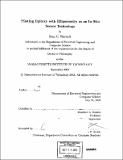| dc.contributor.advisor | Munther A. Dahleh. | en_US |
| dc.contributor.author | Warnick, Sean C. (Sean Charles) | en_US |
| dc.contributor.other | Massachusetts Institute of Technology. Department of Electrical Engineering and Computer Science. | en_US |
| dc.date.accessioned | 2014-06-13T22:30:50Z | |
| dc.date.available | 2014-06-13T22:30:50Z | |
| dc.date.copyright | 2003 | en_US |
| dc.date.issued | 2003 | en_US |
| dc.identifier.uri | http://hdl.handle.net/1721.1/87907 | |
| dc.description | Thesis (Ph. D.)--Massachusetts Institute of Technology, Dept. of Electrical Engineering and Computer Science, 2003. | en_US |
| dc.description | Includes bibliographical references (leaves 107-113). | en_US |
| dc.description.abstract | Epitaxial processes are deposition processes that produce crystalline films with nano-scale precision. Many compound semiconductor devices rely on epitaxy to produce high-quality crystalline films with a specified compositional profile as a function of film thickness. Although various epitaxial processes, such as molecular beam epitaxy or metal-organic chemical vapor deposition, have long been known to be capable of producing such films with mono-layer precision, doing so often requires significant calibration and many trial-and-error attempts before success is realized. Ellipsometry is an established optical characterization method that uses the polarization state of reflected light to determine the alloy composition of a grown film. As a non-invasive sensor technology, ellipsometry has more recently been deployed as an in-situ sensor to characterize films as they grow. This thesis takes a comprehensive view of the issues and impact associated with the use of ellipsometry as an in-situ sensor to control epitaxy in real time. A dynamic model of the physics associated with ellipsometry and growing films is developed from first principles, and this model is used to highlight some of the capabilities and limitations of ellipsometry as a measurement device for feedback control. A control problem is then formulated that substitutes the actual design objective with one more amenable to feedback design, and standard linear tools are used for feedback design. Simulations show that these designs look promising, even for the reliable growth of quaternary graded structures. | en_US |
| dc.description.statementofresponsibility | by Sean C. Warnick. | en_US |
| dc.format.extent | 113 leaves | en_US |
| dc.language.iso | eng | en_US |
| dc.publisher | Massachusetts Institute of Technology | en_US |
| dc.rights | M.I.T. theses are protected by copyright. They may be viewed from this source for any purpose, but reproduction or distribution in any format is prohibited without written permission. See provided URL for inquiries about permission. | en_US |
| dc.rights.uri | http://dspace.mit.edu/handle/1721.1/7582 | en_US |
| dc.subject | Electrical Engineering and Computer Science. | en_US |
| dc.title | Piloting epitaxy with ellipsometry as an in-situ sensor technology | en_US |
| dc.type | Thesis | en_US |
| dc.description.degree | Ph.D. | en_US |
| dc.contributor.department | Massachusetts Institute of Technology. Department of Electrical Engineering and Computer Science | |
| dc.identifier.oclc | 54935687 | en_US |
